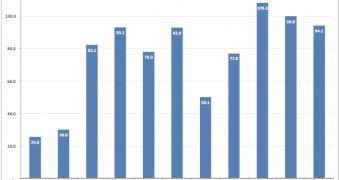Symantec’s November Intelligence Report reveals some interesting details on the evolution of cyberattacks and how many of them were successfully mitigated by the security solutions provider.
Worryingly, on average, 94 targeted attacks were blocked each day in November, the most frequently targeted industry being the public sector with more than 20 attacks blocked daily. The public sector is closely followed by the chemical and pharmaceutical industry, and by the manufacturing sector which recorded close to 14 attacks being blocked each day.
“The aim of these targeted attacks is to establish persistent access to the targeted organization’s network, in many cases with the aim of providing remote access to confidential data. They have the potential to cause serious damage to an organization and in the long term represent a significant threat against the economic prosperity of many countries,” revealed Paul Wood, senior intelligence analyst, Symantec.cloud.
When it comes to spam, the figures showed that there was a 3.7% decrease compared to the previous month; but unfortunately, phishing increased with around 0.04%. The rise may not be significant, but if we consider the fact that one in 300 emails were identified as phishing, it’s not something to neglect.
The most alarming figures were recorded by malicious websites. The report shows that close to 5,000 sites were blocked per day, which translates into an increase of 48% since October.
The numbers that represent malware-containing emails show that 40% of the malicious elements found in email messages pointed to some malevolent website, which reveals a 20% rise compared to October 2011.
The study also shows that the UK is still the leader when it comes to the ratio of malicious emails, followed by Switzerland.
Finally, the report advises organizations on how to protect their infrastructures against online threats. Defense-in-depth strategies, network monitoring, the use of comprehensive endpoint solutions, data encryption and removable media policies are just a few of the recommendations which should be taken into consideration by companies.

 14 DAY TRIAL //
14 DAY TRIAL //